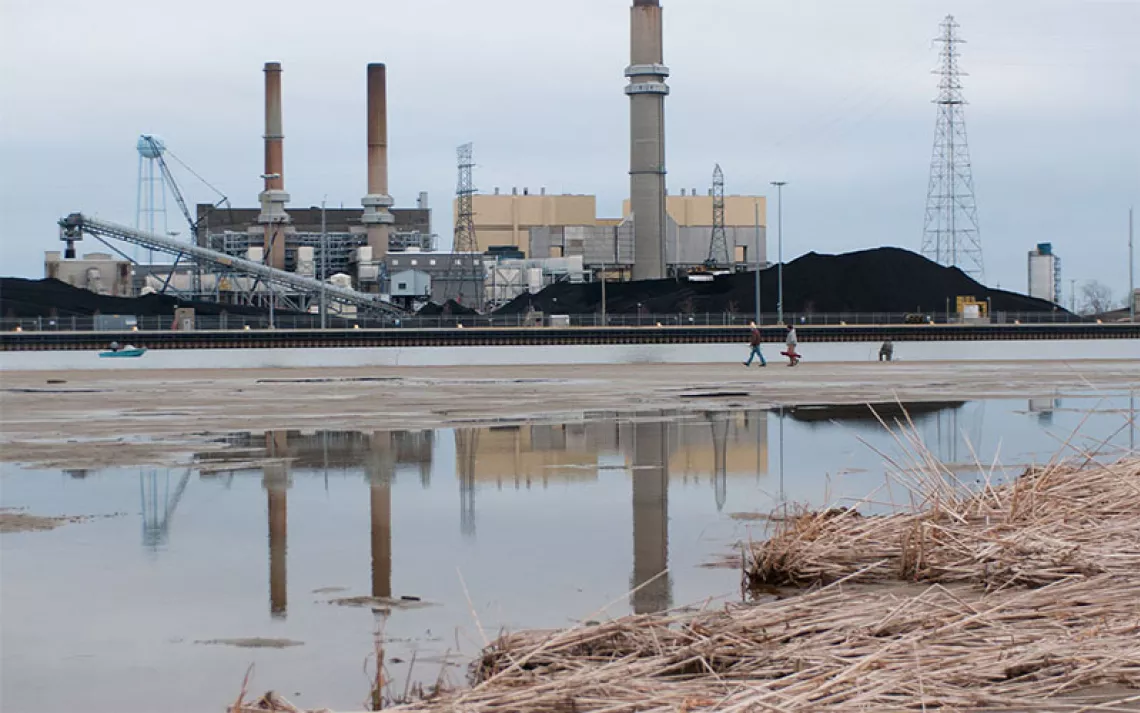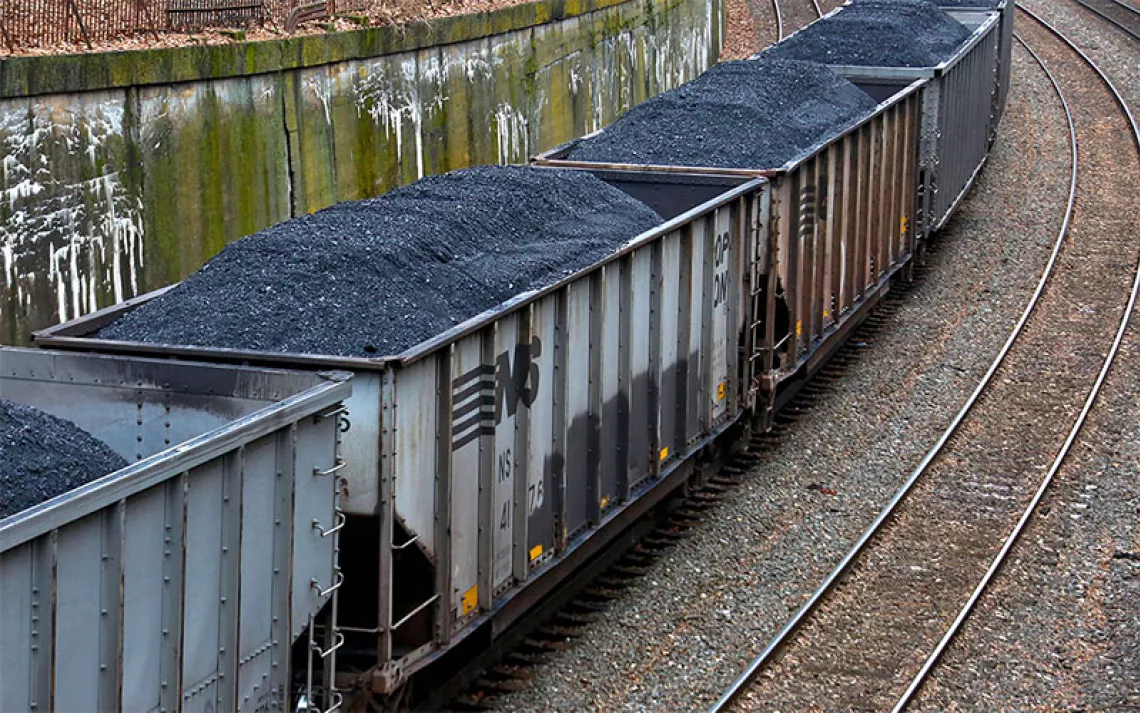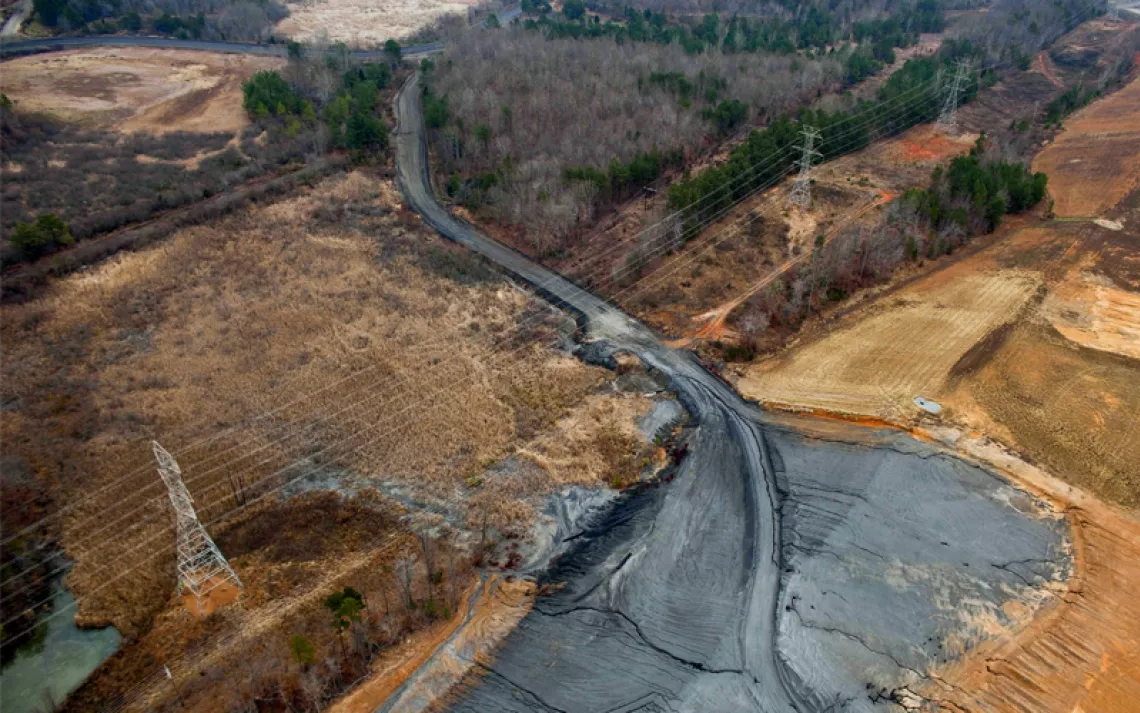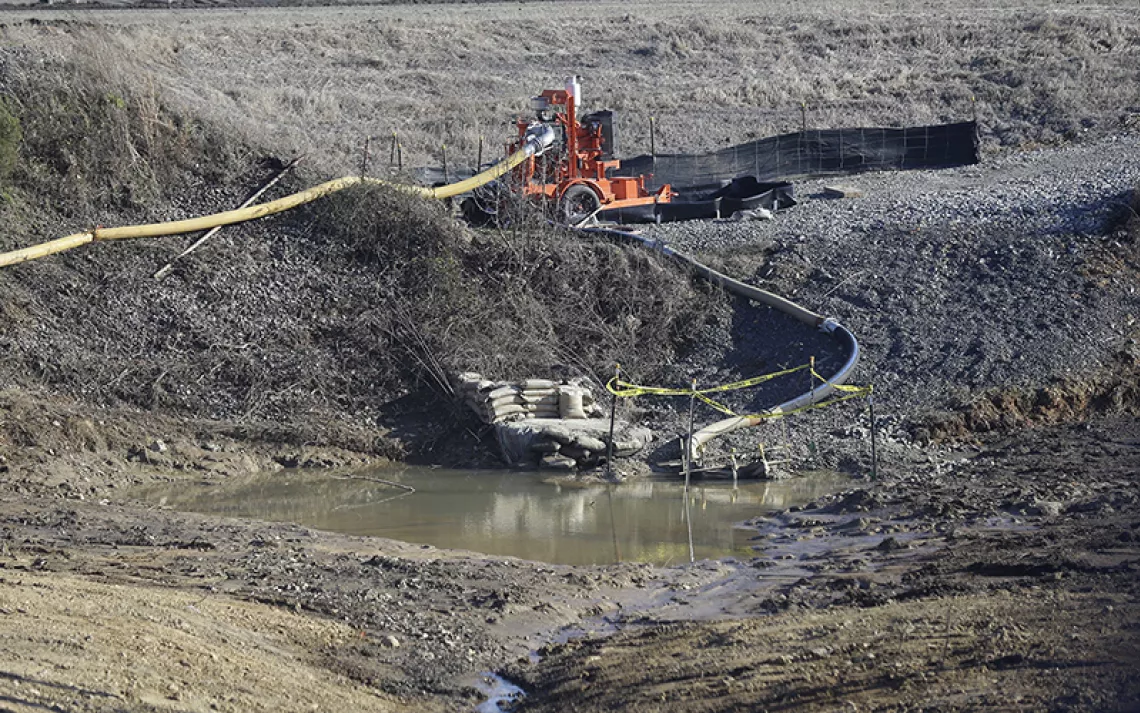Remembering Kingston
On the anniversary of the nation’s largest coal ash spill, disease and death haunt first responders
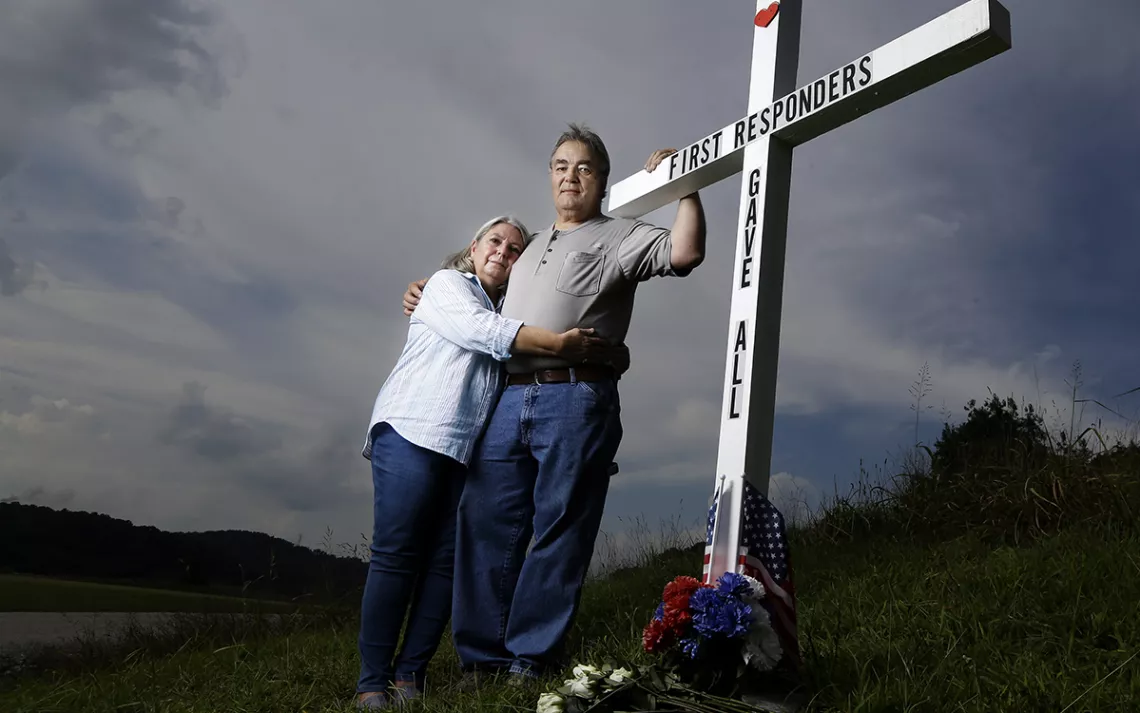
Ansol and Janie Clark | Photo by AP Photo/Mark Humphrey
Three days before Christmas in 2008, Julie Bledsoe woke to her phone ringing. Her husband, Ron, afraid his trio of high schoolers would wake in the dark hours before daylight, ran to answer it. A voice on the other side of the line said there was an emergency.
Around the same time, in a nearby home, Janie Clark’s landline rattled in the kitchen. Janie, still groggy, got up to take the call before handing it off to her husband, Ansol. It was his supervisor at the Kingston Fossil Plant, a coal-fired station run by the Tennessee Valley Authority 40 miles west of Knoxville, Tennessee. When Kingston was built in 1955, it was the largest coal-fired power plant in the United States, and it had been accumulating coal ash—the toxic residue of burning coal for electricity generation—for over half a century. Ansol was told to get down to the plant right away. He quickly dressed and left without taking a shower or packing a lunch.
The men were among the first responders to the largest coal ash spill in US history. Over a billion gallons of Kingston’s coal ash slurry had punched through an earthen wall about six stories tall. After the first day, Ron told his wife the devastation at the site was unbelievable; it looked like the moon. Dozens of homes and 300 acres of rural Roane County, including the Emory and Clinch Rivers, upstream from the Tennessee River, were swamped in a thick gray porridge. All told, it was over five times the size of BP’s Deepwater Horizon oil spill.
Even so, Kingston is infamous for more than just the record size of the spill. It’s also known for the incomprehensible disregard for the safety of the workers who cleaned up the spill.
A decade ago, Janie, Ansol’s wife of nearly 50 years, didn’t know anything about the dangers of coal ash. She was more worried about how fast he was driving to the site and how they’d spend the upcoming Christmas holiday than any fear associated with the spill. The cleanup ended in April of 2015, but today over 40 workers are dead, and according to an ongoing investigation by USA Today-Knox News at least 400, including Ansol and Ron, are experiencing illnesses. Many are deadly, including respiratory problems, heart failure, and cancer.
“I had no idea he would be placed in a situation that would destroy his life,” Janie told me over the phone. “He didn’t either.”
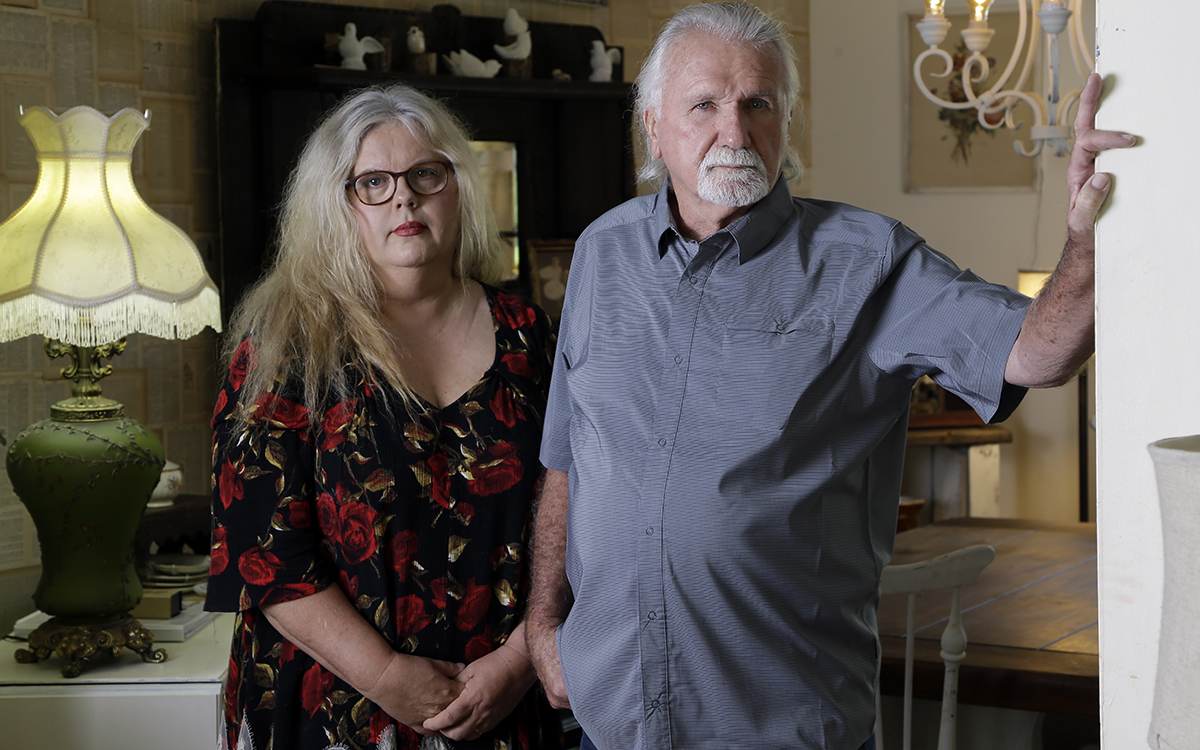
Ron and Julie Bledsoe | Photo by AP Photo/Mark Humphrey
Ansol
During the spill, like many on his crew, Ansol, now 68, worked overtime: 12-to-14-hour days, seven days a week. One year he racked up 3,400 hours. The spill happened in the midst of the recession, and the pay was good. Ansol thought he could use the job to finally save up enough money for retirement and enjoy his golden years. He wanted to take Janie to the beach; she’s never seen the ocean.
Janie started noticing things were off with her husband’s health a year later. In spring 2010, Ansol collapsed in their bedroom while getting ready for work. He’d suffered a stroke, and his doctor diagnosed him with an arrhythmia, or irregular heartbeat. Then in 2012, Ansol started developing coldlike symptoms, which the TVA attributed to allergies. His doctor gave him steroid shots. After taking a month off, he went back to work in fall 2012, but he’d gained almost 40 pounds of fluid in his midsection and legs. His heart wasn’t pumping out fluid properly, and he was treated for congestive heart failure. In 2015, he took early retirement to deal with his increasing illnesses.
Just a few months later, Ansol was looking out the bedroom window when he started making strange sounds. He was standing in the exact same spot of his first stroke. Janie rushed over to him and wrapped her arms around his waist.
“I was yelling, 'Can you hear me?!'” Janie remembered. She struggled to get him to the bed, worried if he fell on the floor she wouldn’t have the strength to lift him back up. She was screaming at him, trying to keep him conscious. “I could tell he was distant,” Janie said. “He was leaving.”
After Ansol’s second stroke, doctors discovered he had a rare form of blood cancer. Instead of a peaceful retirement after a life of hard work, Janie said their lives are now filled with illness, doctor visits, and, to a degree, depression. Through tears, she said her dreams of seeing the ocean are gone. It’s not just the diseases that are traumatic for the couple, but the stress. They know how he attained these diseases, and that their attainment was entirely preventable.
“This is the thing I will carry to my grave: I feel so guilty because I didn’t see it. I didn’t look for the signs that his health was deteriorating. But he was literally poisoned,” said Janie, who described Ansol as a big, strapping man prior to the spill. “He looks like a person who’s been poisoned.”
According to a report by Physicians for Social Responsibility and Earthjustice, coal ash has the “potential to injure all of the major organ systems,” and is linked to a multitude of cancers, heart damage, lung disease, respiratory distress, kidney disease, reproductive problems, and developmental delays in children, as well as neurological damage. A notoriously conservative agency, the EPA’s own reporting has shown that living near coal ash ponds can lead to an increased risk of cancer.
Nevertheless, due to corporate interests, coal ash is not regulated as a hazardous substance by the federal government and is instead regulated like common household waste. But, unlike much of what ends up in your trash bin, coal ash contains deadly toxic metals including arsenic, chromium, lead, mercury, and selenium. The particles of ash are so minute, they can bury deep into respiratory tissues; after they lodge in someone’s lungs, they don’t leave.
Janie recalled watching a 60 Minutes episode just weeks after the spill that featured a TVA representative who said the cleanup was perfectly fine. “What else can you believe when you have people coming out telling you that? There’s not a reason to think they’re not telling the truth,” said Janie, who, like many families, falsely thought the EPA was monitoring the cleanup. “But there was no oversight.”
TVA denies that workers were not informed of the toxic substances they were cleaning up: “The constituents of coal ash have been well-known for years, and TVA was transparent with this information throughout the Kingston recovery project. . . . TVA’s recovery plan was informed by the best available science about coal ash constituents and how to perform the recovery project work safely. And TVA shared that science, including possible health impacts, with the public.”
Although the TVA knew about the toxic elements of coal ash, it failed to protect its workers. It hired Jacobs Engineering, a global contractor based in Texas with a history of worker-safety lawsuits, to lead the cleanup. According to the accounts of dozens of former workers, Jacobs refused basic protective measures including dust masks. It did not inform workers that coal ash was a dangerous substance, and it limited testing for chemical exposure.
Ansol told Janie that during daily safety meetings with his supervisor, he was told the opposite: coal ash wouldn’t hurt him. Tom Bock, Jacobs’s safety manager, told workers they could literally eat coal ash after his own boss, Sean Healey, wrote in an email that workers would “have to ingest about one pound of fly ash per day just to get to the allowable arsenic body burden.” Jacobs management has said this wasn’t meant to be taken literally.
TVA spokesperson Scott Brooks told Sierra that the constituents in fly ash are similar to the constituents in soil. “We wouldn’t recommend you eat either, but it depends on the amount. Anything can be toxic in high enough amounts, and that rule is applied to anything, including coal ash, but we wouldn’t generally recommend you’d eat it any more than you’d eat dirt.” Both Brooks and TVA vice president Scott Turnbow said they weren’t present at the Kingston site during the cleanup and couldn’t comment on what was said there by Jacobs.
While Janie spoke on the phone, Ansol sat in the living room wearing a heart monitor. While workers are dead, dying, or dealing with debilitating diseases, many without health insurance are also dealing with the stress of huge medical bills. Meanwhile, Jacobs was paid $64 million for the cleanup and continues to manage administrative projects for the TVA. Turnbow said that these projects do not involve worker safety.
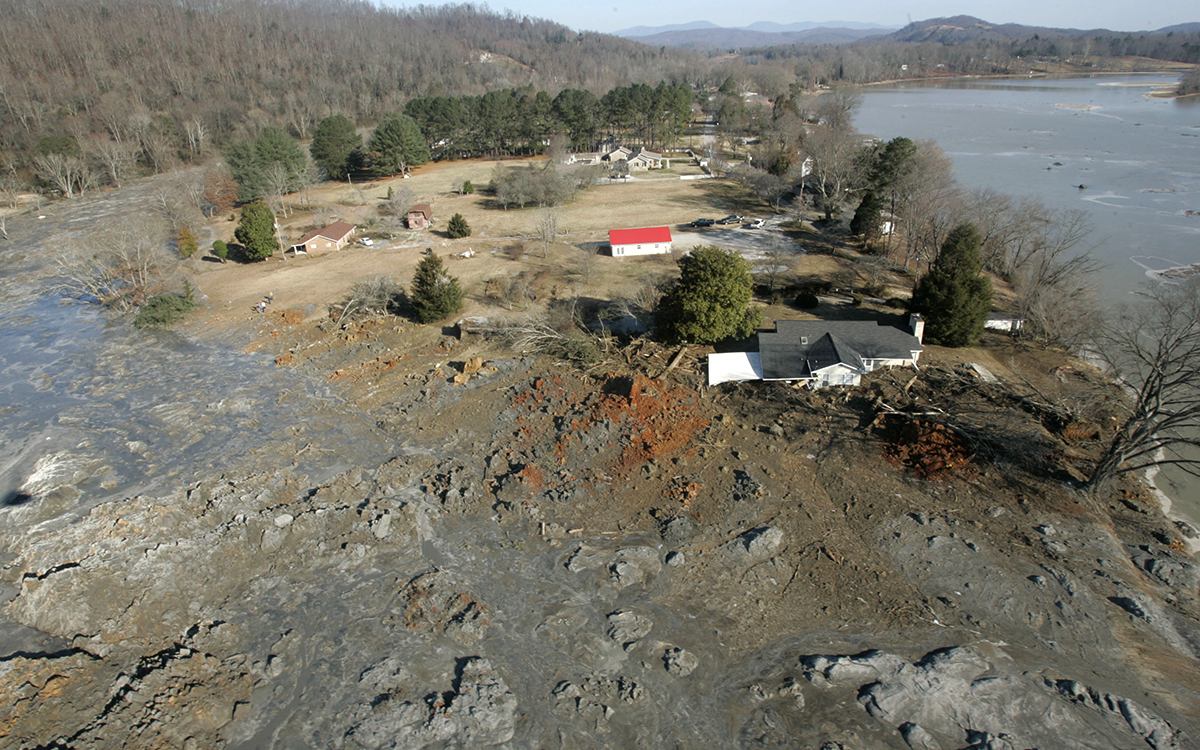
An aerial photo shows homes that were destroyed when a retention pond collapsed. | Photo by AP Photo/Wade Payne
Ron
It was in the summer of 2009 when Ron’s nosebleeds started. After a previous career in the film industry, Ron hauled water at the site to dampen the ash and try to keep it in place. It was easier in the winter and spring. By summer, fly ash—a type of coal ash as fine as talcum powder—wouldn’t stay dry but instead floated through the air.
Julie, 57, remembers Ron coming home with dust on his clothes. They didn’t know the dust was toxic, so Ron would knock his boots off on the porch before setting them inside the door. He’d take his clothes off in the bathroom, and Julie would carry them to the wash, but they left behind grit with a funny odor. Julie had to get two new washing machines during Ron’s job at the site, which she attributes to the build-up of coal ash residue. Repairmen who came to fix the first one said they’d never seen anything like it—the motor had corroded. Ron washed out his ears with Q-tips that blackened at the ends, and he left tissues with gray snot around the house.
According to Julie, Ron was worried and asked to use a dust mask, but his supervisor refused anything beyond a hard hat and an orange vest. “If they’re telling you you don’t need a dust mask, you must not need one,” she remembered telling her husband, brushing off his concerns.
When asked if fly ash is safe to breathe, Scott Brooks reiterated that coal ash is not a hazardous waste and compared protective measures to OSHA guidelines for other types of dust like grain and corn. He said the use of personal protective equipment depends on exposure levels just like any other airborne material.
But Ron’s exposure turned nosebleeds into coughing fits. He developed colds and sinus infections he couldn’t shake. He had trouble laying down flat to sleep at night. His breathing problems led to multiple hospital visits, tests, X-rays, and eventually, an inhaler that cost $400 a month.
“I’m just very naive. I just could not imagine anyone could be that way to a workforce. I’d give anything to make a different decision,” Julie said, her voice breaking when she reconsidered her husband’s initial concerns. “If we’d lost our house and everything we owned, it would’ve been OK.”
“The thing I keep going back to is it was all unnecessary. It was totally unnecessary to do that to these people. They could’ve let them wear a dust mask. Nobody would’ve had a problem saying coal ash can get dangerous at this level. That would’ve been the responsible thing. And the men would’ve kept with it,” said Julie. Now, Ron’s brother, who also worked at the spill, has terminal lung cancer. Five of his closest coworkers are now dead; his former foreman has cancer, and his union steward, a former preacher, is dying.
If a silver lining, however tinny, of this spill exists, it may be that Kingston becomes the nightmare that wakes the US up to the dangers of coal ash. The Kingston spill reignited a debate over the regulation of over 700 coal ash sites across the United States (29 operated by the Tennessee Valley Authority). According to industry data, almost all of these sites continually contaminate groundwater at levels deemed unsafe by the EPA, and a third of them, or 237 sites across the US, could cause the loss of human life and significant environmental damage should they also fail. While scientists have known for decades that coal ash is toxic, coal companies like the TVA have buried these results to mitigate the expenses of properly disposing of coal ash.
Julie wants to build a coalition of everyday Americans across the nation spreading the message that coal ash makes people sick. Neither she nor Janie was involved in any form of environmental activism before the coal ash spill. But they believe telling their stories is an intricate part of dealing with the fossil fuel industry moving forward.
“I think the Kingston coal ash workers are a group of people who were terribly misled,” said Julie. “The good that can come from this is that no other workforce could be treated and disregarded in the way they were. We now know they are the proof that coal ash kills. There doesn’t need to be any more studying done.”
Though she identifies as a shy person, Julie has pushed herself outside her comfort zone to expose the dangers of coal ash, speaking first at community meetings and, in the fall, at an EPA testimony in Washington, DC.
Her testimony was in opposition to revisions proposed by Andrew Wheeler’s EPA to an Obama-era regulation called the 2015 coal ash rule. Though the rule provided stricter regulations for where and how coal ash could be disposed, scientists say it still didn’t go far enough because it failed to categorize coal ash as a hazardous waste. And now, even that half-baked rule is being rolled back. Wheeler, a former coal lobbyist, has argued that it’s too costly for utilities to remove coal ash from their current sites when utilities could instead cap coal ash in place or sell it for beneficial reuse. TVA vice president Turnbow said beneficial use includes concrete production and drywall material.
But newly minted activists like Julie don’t want to pick up a product and wonder if there’s coal ash in it. “I don’t want it recycled,” Julie said. Instead, she wants coal ash moved to well-lined pits (at least 95 percent of coal ash landfills in the US are unlined), high and dry away from both the water table and from people.
In 2013, a coalition of former workers filed a lawsuit against Jacobs for failing to protect them from the fly ash. Though TVA has been involved in other lawsuits related to the spill—it settled with Roane County for $43 million in economic redevelopment and with local residents for $27 million in property damage—it is not a formal defendant in the medical claims lawsuit.
Linking individual illnesses or diseases with contamination is complex. It creates burdensome court battles for the 73 plaintiffs. A year ago, a federal jury ruled that Jacobs failed in its duty to protect workers. According to the jury, this failure, and the subsequent exposure to coal ash, could have resulted in the diseases workers suffer from today. The next phase of the lawsuit will try to establish a direct link between these diseases and coal ash exposure. If successful, it could result in medical claims for workers.
But until that happens, workers continue to die without compensation for their medical bills. TVA’s board of directors rejected a request from former Kingston workers to set up a medical compensation fund for cleanup workers over the summer. According to Brooks, TVA has expressed its sympathies to the workers: “We’re sorry anybody is sick and suffering for any reason. But we have to wait for the legal system to play itself outside and determine what, if anything, may have caused those illnesses and if they have anything in common.” He said that TVA has spoken to workers and their families at hearings and community events but has not reached out to them individually.
Jim Scott, lead attorney in the lawsuit, couldn’t comment on an ongoing case, but he believes that TVA should be open and honest about the cleanup, and it should pay for independent medical monitoring and the testing of workers. “You shouldn’t be asked to give clients' eulogies,” Scott said.
In an online summary of the case published on Jacobs’s website, the contractor claims trial evidence “will show that nothing that Jacobs allegedly did actually caused any injuries that plaintiffs claim. Indeed, Jacobs believes the evidence will show that any injuries plaintiffs claim to suffer were not even connected to the fly ash at the Kingston site.”
“I don’t think it’s a coincidence that many people got sick with those diseases. That defies logic,” Janie said.
According to Brooks, the TVA’S new CEO, Jeff Lyash, recognized that TVA wasn’t doing a great job in how it was interacting with coal ash communities, and in the past six months it's been trying to engage more with local areas.
Both Janie and Julie have met Lyash, and although his demeanor is different from the last CEO's—she describes him as kind and a good listener who has teared up during their testimony—he has told them his hands are tied by the decisions of the board of directors.
Scott thinks this is a mistake. From a moral, legal, and public relations standpoint, Scott said, TVA “will wind up regretting they didn’t do the right thing.” He thinks TVA has cut corners at the risk of human safety while spending money on luxury items like jets and helicopters for upper management. “So when a spouse tells me their husband’s getting blood in their lungs and it fills up so it’s hard for him to breathe, it makes me sick,” Scott said.
Ron, who’s never smoked in his life, developed chronic obstructive pulmonary disease. He got skin cancer on an area exposed to the heavy metals present in coal ash. Now 75, Ron’s retired, but it’s not a welcome retirement. He sleeps with an oxygen mask. It’s especially hard during the winter months, when Ron’s COPD becomes deadly. If their grandchildren—a three-year-old grandson and six-year-old twins—show any signs of sickness, they can’t come anywhere near their home.
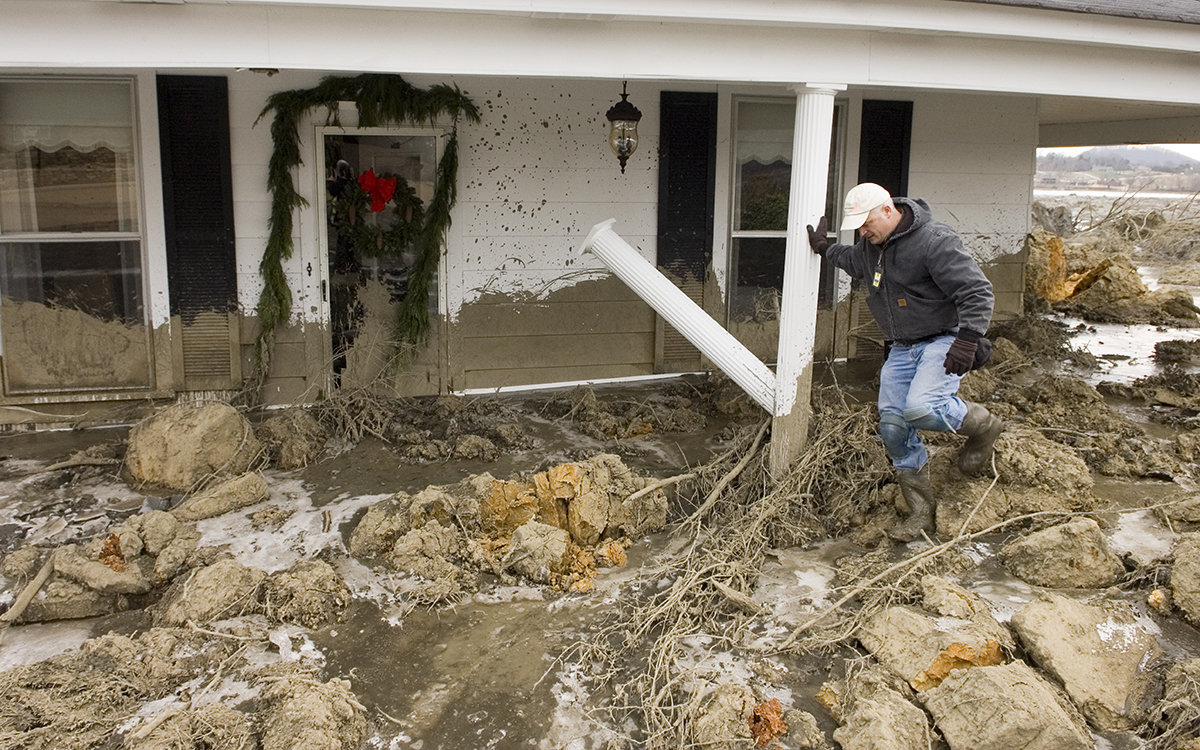
A Tennessee Valley Authority employee surveys a damaged home. | Photo by AP Photo/Knoxville News Sentinel/J. Miles Cary
Jean
In 2008, Jean Nance was in her early sixties and living with her twin sister, Judy Ivens, in Alcoa, Tennessee. She was enjoying her retirement after working for TVA for 44 years by devoting more time to her community (she volunteered at the hospital) and her family (she was the favorite aunt). TVA called her the day after the spill, on December 23, and asked her to come in on Christmas Eve to head security. Judy said that Jean always gave 200 percent; she had an unrivaled work ethic, and more than that, she loved her old employer. So of course Jean said yes. She left the next morning at 3:45 A.M., and she worked at the site almost every day for the next four and a half years.
It wasn’t long before Judy noticed a fine yellow dust coating the navy paint of the car Jean drove to work each day. Jean told her she wiped the same yellow dust off her desk at work, an unventilated trailer where she spent every day filing paperwork and handing out badges. Jean said the dust came from the site. Though she couldn’t see it hanging in the air, Jean said she could taste it. Judy asked if breathing the dust was hazardous for her health, and Jean was very resolute: “No,” Judy remembered her saying. “TVA wouldn’t do that to me.”
She wasn’t the only one. Both Janie and Julie believed the TVA was the best employer in the region. “Everyone in the community did,” Julie said. “The TVA does so much to protect their reputation. They call themselves stewards of the environment.”
Turnbow told me that he believes TVA still has a good reputation. “If you talk to TVA employees today or those who have retired in the past, people are proud to have worked for TVA or proud to now because of the service and mission in the valley that we have served since 1933,” Turnbow said. He also said that TVA has a gold standard for safety and that the region surrounding Kingston is better than it was before 2008.
But less than seven years later, Judy held Jean’s hand at her bedside in an east Tennessee hospital. Jean, whose entire family described her as incredibly healthy, was in for a routine doctor’s appointment five months before when her doctor discovered she had leukemia. Jean would remain hospitalized for the rest of her life, with the exception of the two weeks at home that she used to plan and celebrate her niece's fourth birthday.
Her three siblings accompanied Jean to the cancer institute at Emory University Hospital in Atlanta to see if they matched for a bone marrow transplant. Heartbroken to discover none of them were, Judy said that their family was further devastated filling out a routine questionnaire at the institute. One of the first questions was whether Jean had been exposed to coal ash. That’s when Jean knew. She was devastated that TVA knew about the dangers of working at the site and didn’t protect her.
While waiting for a life-saving bone marrow transplant, Jean underwent multiple rounds of intensive chemotherapy called “blasts.” According to Judy, the last one killed her. At her bedside, Judy recalled pulling her gaze away from Jean’s face, asking the doctor, “Did we do everything we could for her?” and saying, “I’ll never…” when her niece, Sonja, interrupted her.
“I think she just took her last breath,” Sonja said. Then, Judy remembered, Jean was gone.
*
Last year, at the 10-year anniversary of the spill, former workers created a memorial for the sacrifice that first responders made. They considered a plaque but worried no one would see it because it would be flat on the ground. So Ansol volunteered to build a cross. It’s tall and white, on a hillside overlooking the spill site. TVA took a different approach: Instead of apologizing to the workers, TVA used ratepayer money to take out a full-page advertisement in the Roane County News thanking Jacobs Engineering.
Ratepayers may ultimately be on the hook for more than just an ad and the cost of the cleanup. According to USA Today-Knox News, TVA may be paying some, if not all, of Jacobs’s legal bills. TVA spokesperson Brooks told Sierra that there is a clause in the original contract with Jacobs that would make TVA potentially liable for the litigation fees, but it won’t be determined until the court case is over.
Meanwhile, Janie wonders if any of the workers or their families will ever see justice or accountability.
“The only thing we can hope is we can help prevent it from happening somewhere else,” Janie said. “Maybe tighter regulations will be applied, and it’ll never happen again that people will be told it’s safe and harmless. It is not safe and harmless. It is not.”
 The Magazine of The Sierra Club
The Magazine of The Sierra Club
